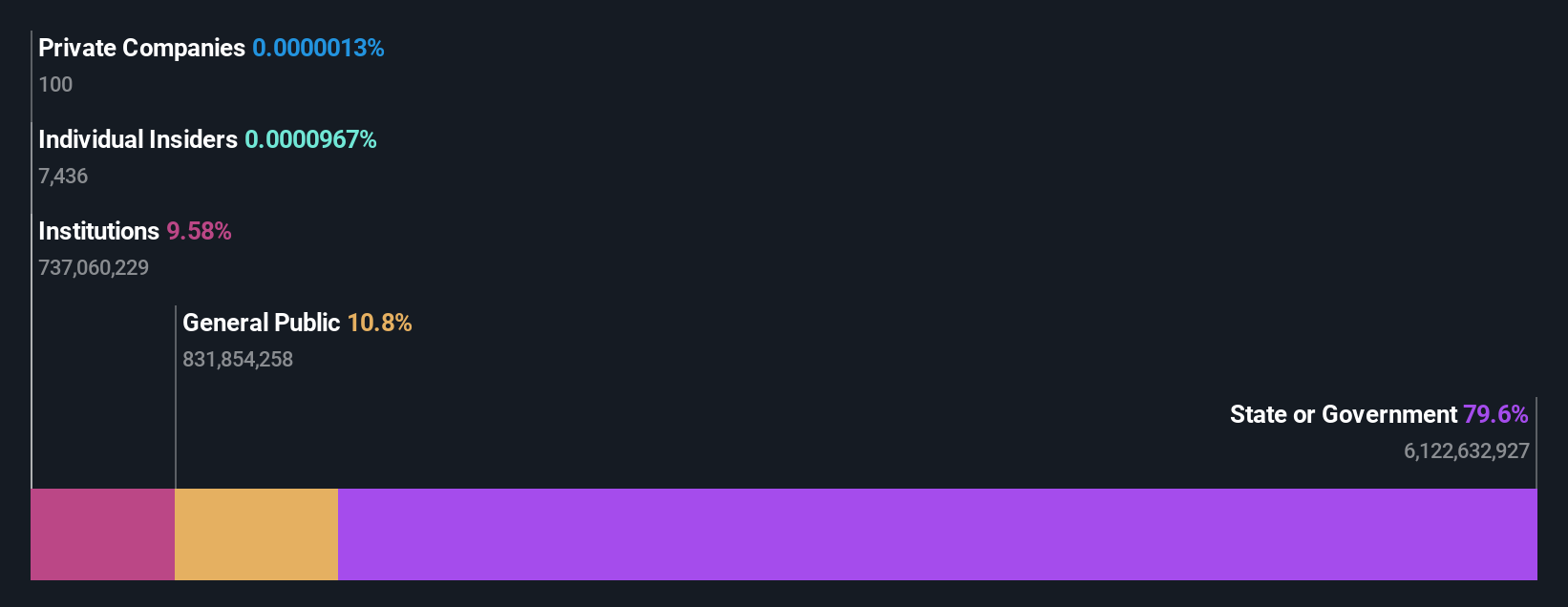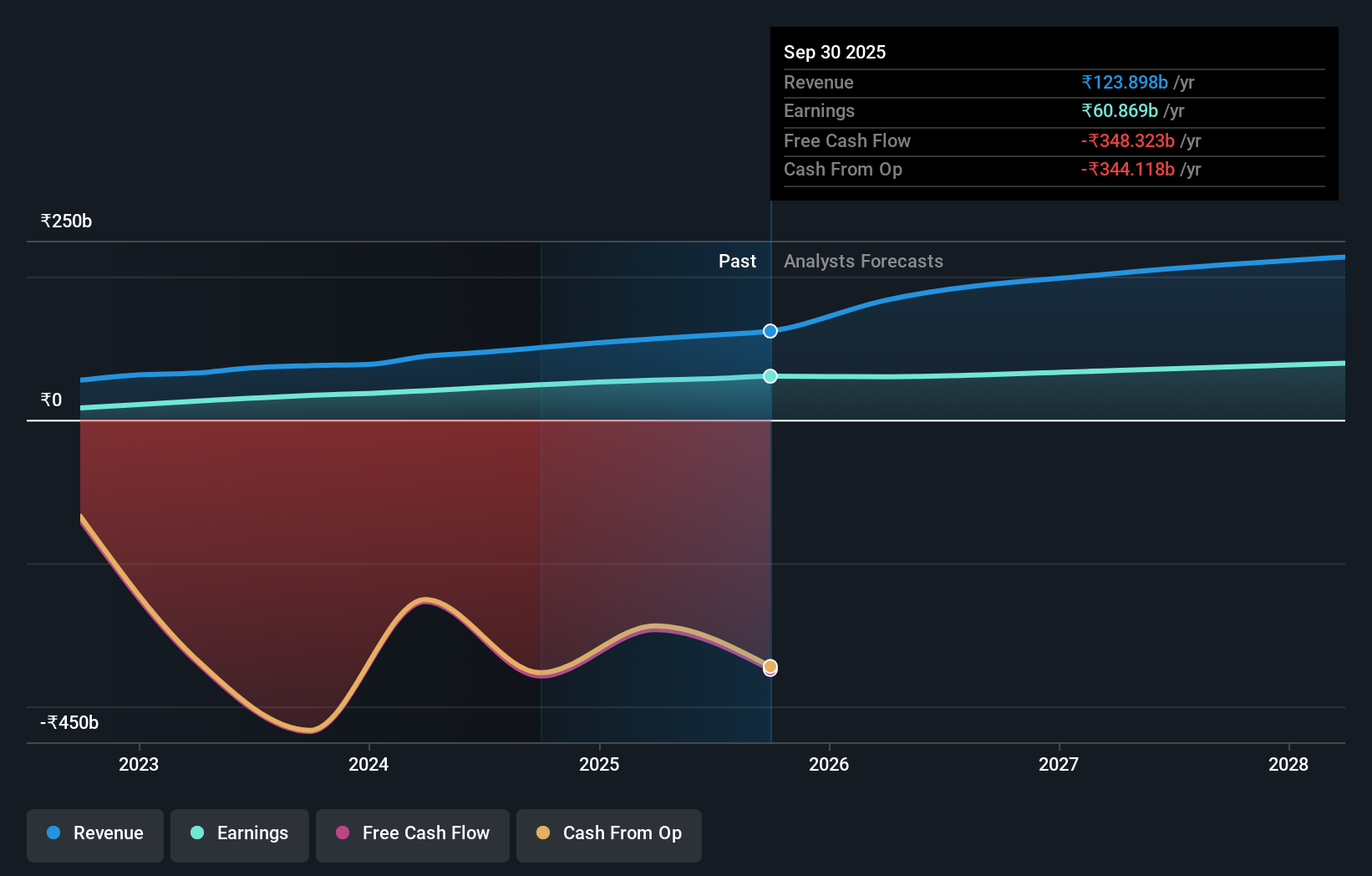Bank of Maharashtra (NSE:MAHABANK) stock most popular amongst state or government who own 80%, while individual investors hold 11%
Key Insights
- Significant control over Bank of Maharashtra by state or government implies that the general public has more power to influence management and governance-related decisions
- 80% of the company is held by a single shareholder (The Government of India)
- Ownership research, combined with past performance data can help provide a good understanding of opportunities in a stock
Every investor in Bank of Maharashtra (NSE:MAHABANK) should be aware of the most powerful shareholder groups. And the group that holds the biggest piece of the pie are state or government with 80% ownership. That is, the group stands to benefit the most if the stock rises (or lose the most if there is a downturn).
Meanwhile, individual investors make up 11% of the company’s shareholders.
In the chart below, we zoom in on the different ownership groups of Bank of Maharashtra.
See our latest analysis for Bank of Maharashtra

What Does The Institutional Ownership Tell Us About Bank of Maharashtra?
Institutional investors commonly compare their own returns to the returns of a commonly followed index. So they generally do consider buying larger companies that are included in the relevant benchmark index.
As you can see, institutional investors have a fair amount of stake in Bank of Maharashtra. This can indicate that the company has a certain degree of credibility in the investment community. However, it is best to be wary of relying on the supposed validation that comes with institutional investors. They too, get it wrong sometimes. When multiple institutions own a stock, there's always a risk that they are in a 'crowded trade'. When such a trade goes wrong, multiple parties may compete to sell stock fast. This risk is higher in a company without a history of growth. You can see Bank of Maharashtra's historic earnings and revenue below, but keep in mind there's always more to the story.

Bank of Maharashtra is not owned by hedge funds. Our data shows that The Government of India is the largest shareholder with 80% of shares outstanding. This essentially means that they have extensive influence, if not outright control, over the future of the corporation. Life Insurance Corporation of India is the second largest shareholder owning 7.1% of common stock, and The Vanguard Group, Inc. holds about 0.8% of the company stock.
Researching institutional ownership is a good way to gauge and filter a stock's expected performance. The same can be achieved by studying analyst sentiments. There is a little analyst coverage of the stock, but not much. So there is room for it to gain more coverage.
Insider Ownership Of Bank of Maharashtra
The definition of an insider can differ slightly between different countries, but members of the board of directors always count. The company management answer to the board and the latter should represent the interests of shareholders. Notably, sometimes top-level managers are on the board themselves.
I generally consider insider ownership to be a good thing. However, on some occasions it makes it more difficult for other shareholders to hold the board accountable for decisions.
Our data suggests that insiders own under 1% of Bank of Maharashtra in their own names. It's a big company, so even a small proportional interest can create alignment between the board and shareholders. In this case insiders own ₹434k worth of shares. It is good to see board members owning shares, but it might be worth checking if those insiders have been buying.
General Public Ownership
With a 11% ownership, the general public, mostly comprising of individual investors, have some degree of sway over Bank of Maharashtra. While this group can't necessarily call the shots, it can certainly have a real influence on how the company is run.
Next Steps:
I find it very interesting to look at who exactly owns a company. But to truly gain insight, we need to consider other information, too. Case in point: We've spotted 1 warning sign for Bank of Maharashtra you should be aware of.
Ultimately the future is most important. You can access this free report on analyst forecasts for the company.
NB: Figures in this article are calculated using data from the last twelve months, which refer to the 12-month period ending on the last date of the month the financial statement is dated. This may not be consistent with full year annual report figures.
Valuation is complex, but we're here to simplify it.
Discover if Bank of Maharashtra might be undervalued or overvalued with our detailed analysis, featuring fair value estimates, potential risks, dividends, insider trades, and its financial condition.
Access Free AnalysisHave feedback on this article? Concerned about the content? Get in touch with us directly. Alternatively, email editorial-team (at) simplywallst.com.
This article by Simply Wall St is general in nature. We provide commentary based on historical data and analyst forecasts only using an unbiased methodology and our articles are not intended to be financial advice. It does not constitute a recommendation to buy or sell any stock, and does not take account of your objectives, or your financial situation. We aim to bring you long-term focused analysis driven by fundamental data. Note that our analysis may not factor in the latest price-sensitive company announcements or qualitative material. Simply Wall St has no position in any stocks mentioned.
About NSEI:MAHABANK
Bank of Maharashtra
Provides various banking products and services in India.
Undervalued with excellent balance sheet and pays a dividend.
Market Insights
Community Narratives



